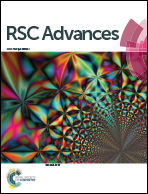Oxidative desulfurization of a model fuel using ozone oxidation generated by dielectric barrier discharge plasma combined with Co3O4/γ-Al2O3 catalysis
Abstract
The oxidative desulfurization (ODS) method is a highly promising method for deep desulfurization. However, the oxidant used most often in ODS is hydrogen peroxide, which can decompose into water and form an oil–water biphasic system, which affects fuel quality and confers difficulty in recovering the oil phase. If a gas is used as an oxidizing agent in ODS, oil–water biphasic problems would not exist. In this study, we synthesized the metal oxide Co3O4/γ-Al2O3 as a catalyst by a two-solvent, impregnation, and adsorption method, producing ozone as an oxidant by the dielectric barrier discharge (DBD) plasma technology, and prepared a model fuel by dissolving representative sulfur compounds such as thiophene (T), benzothiophene (BT), dibenzothiophene (DBT) and 4,6-dimethyldibenzothiophene (4,6-DMDBT) in n-octane. Then, a novel room temperature catalytic oxidative desulfurization method through ozone oxidation combined with Co3O4/γ-Al2O3 catalysis was developed. The method was suitable for the deep removal of sulfur-containing compounds from the model fuel. This desulfurization technology efficiently removed T, BT, DBT, and 4,6-DMDBT, and the sulfur removal of all sulfur compounds exceeded 99%.


 Please wait while we load your content...
Please wait while we load your content...